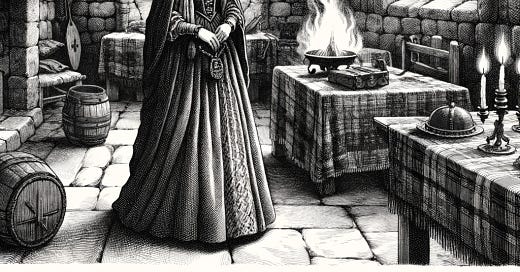In the rich tapestry of Scottish history, the tale of Lady Agnes Randolph, known as "Black Agnes" for her striking dark hair and formidable presence, stands out as a beacon of valor and resilience. Her heroic defense of Dunbar Castle during the First War of Scottish Independence not only demonstrates her tactical acumen but also highlights the pivotal role women played in the medieval conflicts of Scotland.
Noble Lineage and Formidable Spirit
Born into the esteemed Randolph family, Agnes was the daughter of Thomas Randolph, Earl of Moray, a staunch ally and nephew of Robert the Bruce. Her upbringing in a family deeply embedded in the struggle for Scotland's independence imbued her with a fierce sense of national pride and personal duty. These qualities were crucial when she faced one of the greatest challenges of her life—the siege of Dunbar Castle.
The Siege Begins
It was January 1338 when William Montagu, Earl of Salisbury, initiated the siege against Dunbar Castle, aiming to undercut Scottish resistance in the eastern lowlands. With her husband, Sir Patrick Dunbar, away, the responsibility of defending the castle fell squarely on Lady Agnes's shoulders. This task would demand every ounce of her strategic genius and unyielding courage.
Ingenious Defense Strategies
As the English forces assembled, launching heavy stones and missiles at the castle walls, Agnes orchestrated a display of defiance that would become legendary. Each time the castle was bombarded, she had her maids wipe down the damages with their kerchiefs, a mocking gesture that infuriated and demoralized the English troops. This act not only showcased her disdain for the enemy's efforts but also bolstered the morale of her defenders.
The siege engines of the English were formidable, but Agnes’s response was sharper. When the enemy rolled out a massive battering ram, Agnes utilized a giant boulder from the castle's armory. At the perfect moment, her forces dropped the boulder from the battlements, smashing the ram to pieces. This quick-thinking not only thwarted a critical assault but also showcased her ability to use the castle's resources effectively.
Mastery of Psychological Warfare
Lady Agnes's prowess wasn’t limited to physical defenses; her psychological tactics were equally potent. In one chilling episode, the English captured her brother, John Randolph, and threatened to execute him unless she surrendered. Standing atop the battlements, Agnes retorted that his death would leave her as the heir to the family's vast estates, thereby turning a moment of potential personal loss into a calculated rebuttal that emphasized her readiness to sacrifice everything for her cause.
Her interactions with the enemy also included moments of biting sarcasm. When Salisbury sent a team of negotiators to demand her surrender, she mocked their efforts, declaring that the castle's men would keep their posts while the women alone defended the walls, underscoring her contempt for the besiegers and reaffirming her leadership and resolve.
The Siege Lifted
After five grueling months, the siege was lifted. Salisbury, unable to breach the castle's defenses or outmaneuver Agnes's tactical brilliance, retreated. Agnes’s leadership not only saved Dunbar Castle but also inspired similar resistance across Scotland, proving that determination and clever strategy could defy even the most daunting odds.
Legacy of a Warrior Woman
Lady Agnes Randolph’s story transcends the mere defense of a castle. It is a narrative enriched with themes of courage, intellect, and indomitable spirit. Her actions during the siege of Dunbar Castle illustrate not just a leader’s resolve but also the significant role played by women in medieval warfare. Agnes’s legacy endures in Scottish history as a testament to the fierce spirit and tactical ingenuity that characterized Scotland’s storied past, reminding us of the powerful impact one individual can have on the course of history.





